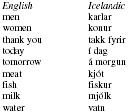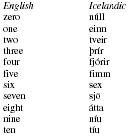Icelanders
PRONUNCIATION: ISE-lann-ders
LOCATION: Iceland
POPULATION: 262,000
LANGUAGE: Icelandic
RELIGION: Evangelical Lutheran Church; other Lutheran denominations; Roman Catholicism
1 • INTRODUCTION
The Republic of Iceland (Lýdveldidh Ísland) is a country of dramatic contrasts and contradictions. It is located near the Arctic Circle but is considered part of Europe. It is one of the world's most volcanically active regions but also the site of Europe's largest ice-cap—hence its nickname, "the land of fire and ice."
Iceland was first settled, mostly by Norwegians, between AD 874 and 930. In 1380, the region—together with Norway—came under Danish rule, which lasted nearly 600 years. A strong nationalist movement late in the nineteenth century led to Denmark granting the Icelanders home rule in 1903 and independence in 1918. However, it was not until 1944 that Iceland fully broke its political ties with Denmark, becoming an independent republic on June 17, 1944.
2 • LOCATION
Iceland is Europe's second-largest island and its westernmost nation. Its total area is 39,769 square miles (103,000 square kilometers), slightly smaller than the state of Kentucky. Iceland is made up of a main island and numerous smaller islands off its shores. The main island has a central plateau ringed with mountains. Iceland has many active volcanoes. On average, there is an eruption about once every five years.
The country's population is about 262,000, of which 90 percent is urban and10 percent rural.
3 • LANGUAGE
Icelandic is a Germanic language. It is most closely related to Faroese (the language spoken on the Faroe Islands). It is also related to Norwegian. The language has changed little since medieval times compared with other modern languages. Most Icelanders can still read thirteenth-century Icelandic sagas in their original versions. A special committee is charged with creating new Icelandic terms for words like "computer" ( tölva , literally "word prophet").

| English | Icelandic |
| men | karlar |
| women | konur |
| thank you | takk fyrir |
| today | í dag |
| tomorrow | á morgun |
| meat | kjót |
| fish | fiskur |
| milk | mjólk |
| water | vatn |

| English | Icelandic |
| zero | núll |
| one | einn |
| two | tveir |
| three | þrír |
| four | fjórir |
| five | fimm |
| six | sex |
| seven | sjö |
| eight | átta |
| nine | níu |
| ten | tíu |
4 • FOLKLORE
Common features of Icelandic folktales include ghosts, elves, mermaids, and sea monsters.
At Christmastime thirteen Santa Claus figures called Christmas Men (or Yuletide Lads) are said to visit every home in the land. They leave gifts but also cause mischief. The Door Slammer disturbs people's sleep by slamming doors. The Candle Beggar steals candles. The Meat Hooker lowers a hook down the chimney in order to make off with the Christmas roast.
5 • RELIGION
Over 90 percent of Icelanders belong to the official state church, the Evangelical Lutheran Church. The entire country makes up a single diocese with 281 parishes. It is headed by a bishop based in the capital, Reykjavík. The Church is government-supported. However, people who do not want their taxes to go for its support may declare this on their returns. Their tax money is then used for other purposes.
6 • MAJOR HOLIDAYS
Iceland's legal holidays include New Year's Day (January 1); Good Friday, Easter Sunday and Monday (late March or early April); the First Day of Summer (celebrated on the third Thursday in April); Labor Day (May 1); Whitsunday and Whitmonday (sometime in May); National Day (June 17); Bank Holiday (first Monday in August); Independence Anniversary (December 1); and Christmas (celebrated December 24–26).
The traditional First Day of Summer is celebrated in April. It is based on a traditional calendar that divided the year into two seasons, summer and winter, each twenty-six weeks long. The occasion is still celebrated as a national holiday with parades and festivals.
7 • RITES OF PASSAGE
Iceland is a modern, largely Christian country. Many of the rites of passage for young people are rituals within the church. These include baptism, first communion, confirmation, and marriage. In addition, a student's educational progress is often marked by graduation parties.
8 • RELATIONSHIPS
Icelanders customarily shake hands when greeting and taking leave of each other. Common greetings include gódan daginn (good day), gott kvöld (good evening), and bless (goodbye). It is considered good manners to take off one's shoes before entering a dwelling.
Icelanders' last names are based on the first names of their parents, with son or sson added for males, and dóttir for females. Icelanders generally call each other by their first names, even in formal situations. They are listed in their country's telephone directories alphabetically by their first, rather than their last, names.
9 • LIVING CONDITIONS
Icelanders enjoy a high standard of living. Traditionally, Icelanders in rural areas lived in dwellings built of stone and turf. Those in the cities had wooden houses. Today most Icelandic housing is built of reinforced concrete. This way it can withstand the country's harsh climatic conditions. Exteriors are generally painted in pastel colors. In Reykjavík, it is common to heat one's house with water from hot springs.
10 • FAMILY LIFE
Icelanders tend to have a rather casual attitude toward marriage. Over 70 percent of firstborn children are born to unmarried couples. It is common for couples to have their own children present at their weddings, often as bridesmaids or pageboys. Married women often keep their original names. In Reykjavík, day care is readily available for the children of working couples. In smaller towns and in rural areas, parents are more likely to rely on family and friends to assist with child care.
The position of women is generally good in Iceland. Iceland is traditionally a matriarchal (led by women) society. Almost 90 percent of Icelandic women work outside the home. In 1980 Iceland became the first country in the world to elect a woman as president. President Vígdis Finnbogadóttir narrowly defeated three male opponents in the 1980 election. She was reelected in 1984, 1988, and 1992.
11 • CLOTHING
Icelanders wear modern, Western-style clothing. The women's traditional costume is worn for festivals and other special occasions. It consists of a white blouse and ankle-length black skirt, with a black vest laced in front, long white apron, black shoes, and black cap.
12 • FOOD
Fish, mutton, and lamb are staples of the Icelandic diet. Common varieties of fish—often eaten raw—include cod, salmon, trout, halibut, and redfish. Raw pickled salmon is a special favorite. Hangikjöt (smoked mutton) is a festive dish served at Christmas and New Year's, and at other times as well. Usually, it is accompanied by potatoes, white sauce, and peas. Skyr is a popular yogurtlike dairy food served either at breakfast or as a dessert, often with berries or other fresh fruit…
13 • EDUCATION
School is required between the ages of seven and fifteen, and all levels of education, including college, are free. Many five-and six-year-olds are enrolled in preprimary education. Primary school covers all subjects, including vocational guidance. Secondary schools offer either general education, vocational education, or university preparatory study. In 1991 Iceland had five universities and colleges, including the University of Iceland, located in Reykjavík.
Recipe
Mondlukaka
(Almond Cake)
Ingredients
- 1 cup butter
- 1 cup sugar
- 4 eggs, separated
- 1 teaspoon vanilla
- 1 cup blanched almonds, ground
- 1 cup flour
- ½ teaspoon baking powder
- ½ cup strawberry jam
- 1 cup heavy cream, whipped
- 3 Tablespoons sugar
Directions
- Beat butter until light and creamy. Gradually beat in 1 cup of sugar.
- Add egg yolks, one at a time, beating well after each addition. Stir in vanilla and ground almonds.
- Add flour and baking powder gradually, mixing well.
- In a separate bowl, beat egg whites until stiff.
- Stir beaten egg whites into batter carefully, using a spatula.
- Preheat oven to 350° F . Grease three 8-inch round cake pans.
- Divide batter among the three pans and bake 30 minutes until golden brown.
- Cool in the pans for 5 minutes. Then remove from pans and cool completely.
- Beat heavy cream with sugar. Spread strawberry jam between layers. Just before serving, spread top and sides with whipped cream.
Adapted from Hazelton, Nika Standen. Classic Scandinavian Cooking. New York: Scribner's Sons, 1987, p. 180.
14 • CULTURAL HERITAGE
Iceland's most famous literary works are the Viking sagas, dating back to the tenth century AD . These family stories describe the important political and military events of their time and the daily lives of the early Icelandic settlers.
Traditional folk musical instruments have almost disappeared. A textbook was published in 1855 describing how to play the langspil , a long and narrow harp. The fióla is a stringed instrument that sits on a table and is played with a bow.
Iceland's best-known twentieth-century author is novelist Halldór Laxness, who won the Nobel Prize for literature in 1955. Other cultural resources include a national orchestra, an opera company, several theater companies, and the Icelandic Dance Company. Well-known names in the visual arts include those of sculptor Asmundur Sveinsson, and artists Jon Stefansson and Kristin Jonsdóttir.
15 • EMPLOYMENT
Icelanders are hard workers. Their average work week of over forty-six hours is one of Europe's longest. Many Icelanders hold two or even three jobs. It is common for children to work during their school vacations. Many even have evening jobs during the school year. Fish processing and other industries employ nearly one-fifth of Iceland's work force. Government employs an equal share.
16 • SPORTS
Not surprisingly, Icelanders, who live surrounded by water, are swimming enthusiasts. Soccer is another favorite activity, and Icelanders excel at sports requiring physical strength, such as weight lifting. Other popular sports include golf, basketball, badminton, horseback riding, hunting, fishing, and sailing. Icelanders have their own native form of wrestling called glîma.
17 • RECREATION
Icelanders are avid readers. Their country is said to have more bookstores relative to its population size than any other in the world. Most families own good-sized book collections.
Chess is extremely popular in Iceland. The legendary 1972 world championship match between American Bobby Fischer and Russian Boris Spassky was held in Iceland's capital, Reykjavík. Bridge (a card game) is another favorite form of recreation in Iceland.
18 • CRAFTS AND HOBBIES
Icelandic crafts include traditional hand-knitted woolen sweaters, ceramics, and jewelry.
19 • SOCIAL PROBLEMS
Iceland has a very low crime rate. Crimes by Icelanders are related to the use of alcohol. With the exception of alcohol use, however, Iceland has fewer drug-related problems than most other European countries. Reykjavík is one of the world's safest capital cities.
20 • BIBLIOGRAPHY
Hazelton, Nika Standen. Classic Scandinavian Cooking. New York: Scribner's Sons, 1987.
Leepthien, E. Iceland . Chicago: Children's Press, 1987.
Levanthes, Louise E. "Iceland: Life Under the Glaciers." National Geographic (February 1987): 184–215.
Roberts, David. Iceland. New York: H. N. Abrams, 1990.
Scherman, Katherine. Daughter of Fire: A Portrait of Iceland. Boston: Little, Brown, 1976.
WEBSITES
Embassy of Iceland, Washington, D.C. [Online] Available http://www.iceland.org/ , 1998.
World Travel Guide. Iceland. [Online] Available http://www.wtgonline.com/country/is/gen.html , 1998
it provided a lot of info i needed for a unit project!!!!
i needed the information for a huge 20 pg. paper on a country of my choice and since i lived there for 2 yrs i thought this would be cool thank you again.
This website really helped alot for my prjoect though. i really liked it.